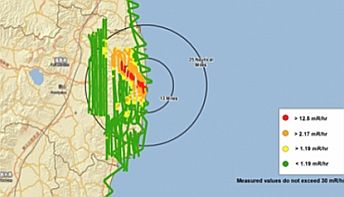
Publisher:
Bonnie King
CONTACT:
Newsroom@Salem-news.com
Advertising:
Adsales@Salem-news.com

~Truth~
~Justice~
~Peace~
TJP
Mar-23-2011 13:09

 TweetFollow @OregonNews
TweetFollow @OregonNews
DOE Actively Misleads on Risks of Radiation Exposure
Craig Gurian, Remapping DebateWe were interested in how the government translates differing potential levels of airborne concentrations of Cesium-137...
 Courtey: Remapping Debate |
(NEW YORK) - The U.S. Department of Energy yesterday released maps showing levels of radiation observed to have been released from the damaged Fukushima nuclear power plants in Japan, the accuracy of which Remapping Debate has no reason to doubt; more revealing, however, was the explanatory material that DOE included in the slide show purportedly to put the data in context. On that front, it is clear that DOE was being misleading — selectively using and omitting information to downplay the general risk that radiation poses to the public in situations separate and apart from that which may be currently occurring in Japan.
The behavior is consistent with what Remapping Debate has found over the last several days of reporting: when asked about what level of radiation would be “of concern” in terms of potential medium- and long-term increases in adverse public health consequences, neither DOE, the Environmental Protection Agency, nor the Nuclear Regulatory Commission is prepared to answer directly and straightforwardly.
Now you see it, now you don’t
Thus, DOE’s chart of “radiation doses explained” shows an NRC annual exposure limit of 5,000 millirems for nuclear plant workers and describes the EPA’s “protective action guidelines” as recommending the implementation of protective measures when there is exposure of 1,000 millirems over four days. (DOE describes the average U.S. annual dose of radiation from natural and manmade sources as 620 millirems.)
DOE omits to mention that the recommendation of the National Council on Radiation Protection and Measurements — which was chartered by Congress in 1964 to study and report on radiation protection and measurements — in respect to annual effective dose limits for the public in the case of continuous or frequent exposure is only 100 millirems; NRRP further recommends that fetal exposure not to exceed 50 millirems in any single month.
DOE also fails to explain that EPA’s protective action guidelines specifically disclaim the use of those guidelines for the determination of a “safe” level of radiation: the guidelines “do not imply an acceptable level of risk for normal (nonemergency) conditions,” the guidelines themselves state. “They also do not represent the boundary between safe and unsafe conditions.” On the contrary, they represent a cost-benefit analysis that, for purposes of potential cancer and genetic effects, is mediated by considerations of what is “reasonably achievable” in emergency conditions. A decision that avoidance of a level of radiation exposure is not reasonably achievable in emergency circumstances — and thus does not warrant the use of overtaxed emergency resources — does not mean that the exposure is safe.
Finally, DOE’s reference to activation of protective action guidelines over the course of four days fails to mention that nuclear events don’t simply end in the manner of a fire being put out: intermediate- and long-term risks are created when radioactive materials are deposited in the environment.
According to Damon Moglen, Climate and Energy Project director at Friends of the Earth, “With Cesium and Iodine, one of the things we’ve got to be worried about is not just external doses; we have to be worried about inhalation and ingestion. And when we hear that water is contaminated, milk is contaminated, and green leafy vegetables are contaminated, we’ve just found the immediate pathway into the human body.”
Indeed, EPA’s intermediate term protective action guidelines for food come into play at levels lower than the 1,000 millirems that DOE references.
 |
Articles for March 22, 2011 | Articles for March 23, 2011 | Articles for March 24, 2011
Salem-News.com:

Quick Links
DINING
Willamette UniversityGoudy Commons Cafe
Dine on the Queen
Willamette Queen Sternwheeler
MUST SEE SALEM
Oregon Capitol ToursCapitol History Gateway
Willamette River Ride
Willamette Queen Sternwheeler
Historic Home Tours:
Deepwood Museum
The Bush House
Gaiety Hollow Garden
AUCTIONS - APPRAISALS
Auction Masters & AppraisalsCONSTRUCTION SERVICES
Roofing and ContractingSheridan, Ore.
ONLINE SHOPPING
Special Occasion DressesAdvertise with Salem-News
Contact:AdSales@Salem-News.com
googlec507860f6901db00.html


Terms of Service | Privacy Policy
All comments and messages are approved by people and self promotional links or unacceptable comments are denied.
RANDRAND March 23, 2011 4:29 pm (Pacific time)
if they ;ie and tap-dance long enough, maybe someone will be left alive at the end of the sad and pitiful performance to applaud and say "BRAVO"-I AM NOT ONE OF THOSE PEOPLE-IT IS MORE OF THE CONSPIRACY TO DO US ALL IN---
Stuart March 23, 2011 2:10 pm (Pacific time)
Thanks for writing this story. Well done. stuart@hotmail
[Return to Top]©2025 Salem-News.com. All opinions expressed in this article are those of the author and do not necessarily reflect those of Salem-News.com.